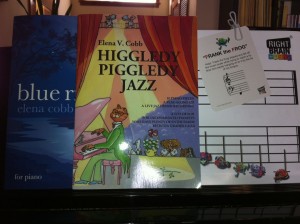Great Finds: Teaching Tools for Troubled Readers & Jazz from Elena Cobb
It’s an important question that we often ask ourselves as we sit attempting to help an individual student conquer a concept or skill. How do you learn? How can I best help you? It’s also an important question to ask ourselves about ourselves. How do I learn? Unfortunately, if we are not careful, our dominant way of learning also becomes our dominant way of teaching.
This week I’m featuring some materials with strategies that will be a welcome addition to your teaching tool box along with some jazz repertoire, from across the pond, that will brighten up your summer and fall.
Right Brain Music
The materials in Right Brain Music combine right brain techniques with traditional notational teaching, specifically giving students a picture to associate with each pitch on the grand staff (26 in all). Get ready to meet the Dozing Dragon, Ellie the Elephant, Caribbean Crocodile, Buff Broccoli who won 1st place in the Worldwide Body Building Competition and the adorable Frank the Frog who fell of the staff while trying to catch a fly and is barely holding on to it by the tip of his tongue.
Available are charts, stickers, flash cards, a memory game, and practice book. These teaching tools, I believe, are intended as supplemental overlays for whatever method the teacher is using. The cards can be pulled out according to the sequencing of any method or according to the pitches that a student is having trouble recognizing and remembering.
In addition to school age children who for one reason or another find reading a challenge, I can see this tool being quite helpful with very young children who would benefit from getting to know a few characters and stories first, then making up their own stories and songs, and finally moving the characters to their “homes” on the keyboard.
One shortcoming I find is that there is no way for sharps or flats to be shown. To me, the pitch Ab is simply not A. I’m always on my students for naming notes without including the accidentals and/or key signature. In my experience when students say A, they play white key A because that is the picture and sound that shows up in their brain. Ab is a different keyboard location and a different sound.
Options are totally open to individualize these materials and create your own activities. The pages are clean and free from distractions. There aren’t a ton of detailed directions. There are several videos available on the site which demonstrate how to turn a child from frustrated and unhappy with learning into a child who is confident and having fun.
Hummingbird
If you want to go way out of the box- wait, there simply is no box on this one- take a gander at Hummingbird. This new system of notation might just be a bridge to help a student who has been unsuccessful with traditional reading.
Each pitch name has it’s own symbol which is always the same no matter which octave of staff it appears in. It also has it’s own guide word (A Above, G Groove, B Below, E Empty, etc) which really confused me for a bit because I couldn’t figure out what the above or below meant to do. But, we are clear now and in the words of some pirates, “We waive that point. We do not press it. We look over it.”
You could change the guide words to anything really and I like the fact that each the picture/symbol is the same for each letter no matter the octave or staff. Only 7 symbols need to be learned. The pitches are always given and the line or space is only octave information. This could be quite useful, on it’s own, with someone who is having trouble recognizing pitches since the rhythm information is not attached to the actual pitch in this system. For example, you could make a hybrid of the pitch system from Hummingbird and traditional notation for an older student who has never been successful at reading.
I also really like the fact that the sharp and flat information is directly attached to each note and written intuitively (arrow up/arrow down) rather like 8va is written in traditional notation. As a seasoned reader of traditional notation, I find it almost impossible to read the note heads as pitch only and to find the duration information in another place, even though there is a certain logic to separating them. I’m sure that someone learning to read for the first time would have no such problem understanding the system and being able to read well.
Songs and tutorials are available on the site. If you wish to get involved in creating or notating pieces in Hummingbird, or have your class or studio be part of their in-house research, you can click on this link. They are working on open source software to translate traditionally notated pieces into Hummingbird, so developers are welcome and needed too.
Higgledy Piggledy Jazz & Blue River
Elena Cobb’s Higgledy Piggledy Jazz (Amazon UK, USA )is truly fun to play. The included live tracks stand alone as a recording as well—without the count in that is—but trust me, the little ones here loved listening to them.
The pieces are definitely late elementary to middle intermediate. The rhythms are authentic and catchy. In the 12 Bar Blues style pieces, Elena has used color to code the changes in position, using red for dominant and green for subdominant.
I especially loved I Ate All The Choc’late. The words fit the tricky opening rhythm perfectly and the walking bass in the LH is easy to master and apply to the IV and V7 chords. The B section has a written out comp with the opportunity for the student to either swap out the RH part for an improv or collaborate with another musician. In fact, collaborating with others is easy because there are volumes available for Alto Saxophone and Guitar Ensemble.
The compositions in Blue River were written for middle intermediate to advanced pianists. The rhythms, forms, and harmonies are sophisticated and the textures totally satisfying. Here you will find all manner of jazz and blues styles—Boogie-Woogie to Latin to Pop.
My favorites are the two Latin pieces, Cloud Seven, Latin and Tango Leone. These two pieces really are infectious. The syncopation is logical but still surprising and the writing falls so well under the hands that you just can’t help smiling as you dig in.
For a chance to win a copy of one of Elena’s books leave a comment below with your name or click on the Facebook or Google+ post with the link to this article and like it by Saturday June 15 at 5pm EST. You can get there from the widgets in the right hand column on this page. Elena is offering one book each (HP Jazz and Blue River) and one download of Blue River – three winners in total.




Hello! I once had the thought of letting my piano students try out Jazz piano, but just didn’t have the chance to try it. Now you recommend the books, I think it’s time! Thx for recommending!
Good article, thank you! I have one student who struggles with playing music of any sort EXCEPT jazz – he excells at that, and I’m always looking for good repertoire for him to learn. I will be looking into the books you mentioned.
These sound so fun!
All but one of the boys in my studio are jazz fanatics! Thanks for offering the giveaway!
The jazz book sounds like a delight to teach and listen to!
So refreshing to see jazz repertoire be included in so many examination lists and festival lists. When I was young, it was not included in most syllabus listings.
I think the jazz books will be perfect for what we’re working on In our studio this summer and fall!